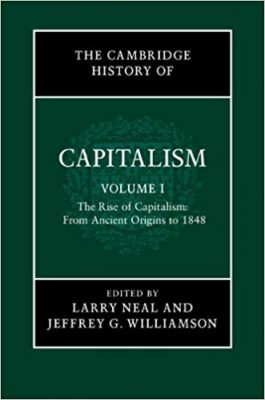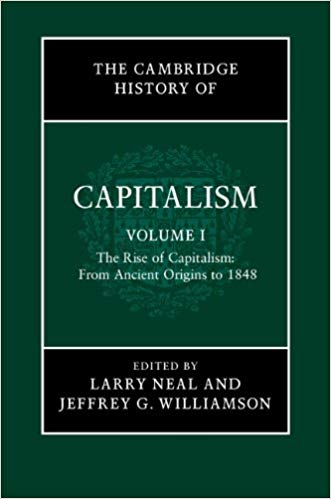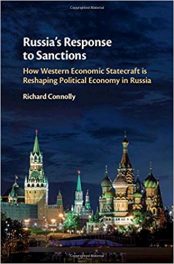 Volume I – The Rise of Capitalism from Ancient Origins to 1848 – 616 pages
Volume I – The Rise of Capitalism from Ancient Origins to 1848 – 616 pages
Volume II – The Spread of Capitalism from 1848 to the Present – 567 pages
Editors: Larry Neal and Jeffrey G. Williamson
Publisher: Cambridge University Press
Book Review by: Sonu Chandiram
Modern-day economic growth, generally defined by economists as a sustained rise in per capita income along with a rise in population, began not too long ago, perhaps around the middle of the nineteenth century, from the 1850s onward, the editors of this book Larry Neal and Jeffrey G. Williamson point out in the Introduction.
Higher levels of prosperity attained as a result of sustained economic growth did not certainly come about before the end of the seventeenth century, they assert. They have been studying world economic history for a long time, and I trust they are more or less right about this time frame, as well as the role of capitalism in generating and distributing new income among people.
At the beginning of such regular growth, it took place only within the lands of ‘a favored few nations,’ Neal and Williamson add. The British and the Americans were among the first to embrace capitalism and its several beneficial features that helped create wealth for families (as opposed to monarchs in the past who used their power to enrich only themselves).
This book on capitalism and how it emerged and developed in various regions of the world is a very informative one, even if your particular areas of curiosity and interest do not include topics relating to business and economics, but include history, politics, and the social sciences. It is also a useful one if you believe capitalism is not among the best means of creating higher standards of living for everyone, but rather that it is responsible for income equality.
As a matter of fact as you read this book, you will note that not only was the connection between capitalism and modern economic growth difficult to see for some people in its early stages, the ‘visible hardships’ it inflicted on some societies repelled some people, the editors point out.
Forty-one specialists in business, classics, economics, history, humanities, international studies, law, and social science, from 15 countries – Austria, Canada, Denmark, France, India, Israel, Italy, the Netherlands, Norway, Portugal, Singapore, Spain, Switzerland, the United Kingdom, and the United States – authored or coauthored the chapters of this book.
We list below the titles of the 34 chapters of this two-volume book of nearly 1200 pages to provide you an overview of its coverage:
Volume I – The Rise of Capitalism from Ancient Origins to 1848
Figures
Maps
Tables
- Introduction
- Babylonia in the first millennium BCE – economic growth in times of empire ‘
- Capitalism and the ancient Greek economy
- Re-constructing the Roman economy
- Trans-Asian Trade, and the Silk Road, deconstructed (antiquity, middle ages)
- China before capitalism
- Capitalism in India in the very long run
- Institutional change and economic development in the Middle East, 700-1800
- Markets and coercion in medieval Europe
- The via italiana to capitalism
- The Low Countries
- The formation of states and transitions to modern economies: England, Europe, Asia
- Capitalism and dependency in Latin America
- The emergence of African capitalism
- Native Americans and exchange: strategies and interactions before 1800
- British and European industrialization
- America: capitalism’s promised land
- The political economy of rising capitalism
Volume II – The Spread of Capitalism from 1848 to the Present
Figures
Tables
- Introduction: the spread of and resistance to global capitalism
- The spread of manufacturing
- Growth, specialization, and organization of world agriculture
- Technology and the spread of capitalism
- Spread of legal innovations defining private and public domains
- Forms of global capitalism
- Enterprise models: freestanding firms versus family pyramids
- Financial capitalism
- International capital movements and the global order
- Capitalism and the colonies
- Capitalism at war
- Modern capitalism: enthusiasts, opponents, and reformers
- Labor movements
- Private welfare and the welfare state
- Capitalism and human welfare
- The future of capitalism
The pros and cons of capitalism revealed in this book in various events in this history of capitalism help us understand it better and create in our minds a balanced view of this economic philosophy. Read the facts discussed in this history and understand the viewpoints expressed by the editors and authors of the essays presented in this important, valuable work.
Editors:
Larry Neal is Emeritus Professor of Economics at University of Illinois at Urbana-Champaign, Research Associate at the National Bureau of Economic Research, and Visiting Professor at the London School of Economics and Political Science.
Specializing in financial history and European economies, he is author of The Rise of Financial Capitalism: International Capital Markets in the Age of Reason (Cambridge University Press, 1990), The Economics of Europe and the European Union (Cambridge University Press, 2007), and ‘I Am Not Master of Events’: The Speculations of John Law and Lord Londonderry in the Mississippi and South Sea Bubbles (2012) He is coauthor of The Origins and Development of Financial Markets and Institutions: From the Seventeenth Century to the Present (Cambridge University Press, 2000).
Jeffrey G. Williamson is Emeritus Laird Bell Professor of Economics at Harvard University in Cambridge, Massachusetts, and Honorary Fellow in the Department of Economics at the University of Wisconsin in Madison. He is also Research Associate at the National Bureau of Economic Research, Research Fellow at the Centre for Economic Policy and Research, and has been a visiting professor at 17 universities around the world.
Professor Williamson specializes in development, inequality, globalization, and history., and is the author of around 230 scholarly articles and 30 books, his most recent being Trade and Poverty: When the Third World Fell Behind (2011), Globalization and the Poor Periphery Before 1950 (2006), Global Migration and the World Economy (2005, with T. Hatton) and Globalization in Historical Perspective (2003, edited with M. Bordo and A.M. Taylor)







